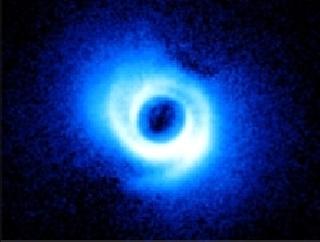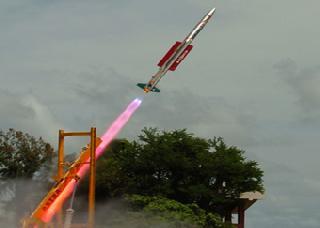
Two spiral arms emerge from the gas-rich disk around SAO 206462, a young star in the constellation Lupus. This image, acquired by the Subaru Telescope and its HiCIAO instrument, is the first to show spiral arms in a circumstellar disk. The disk itself is some 14 billion miles across, or about twice the size of Pluto's orbit in our own Solar System. A NAOJ/Subaru photo
WASHINGTON (PTI): Scientists have found a disk of gas and dust around a young Sun-like star with spiral-arms, which may provide clues to the presence of embedded but yet-unseen planets.
The newly imaged disk surrounds SAO 206462, an 8.7-magnitude star located about 456 light-years away in the constellation Lupus.
"Detailed computer simulations have shown us that the gravitational pull of a planet inside a circumstellar disk can perturb gas and dust, creating spiral arms. Now, for the first time, we're seeing these dynamical features," said Carol Grady, an astronomer with Eureka Scientific, based at NASA's Goddard Space Flight Center in Greenbelt.
Astronomers estimate that the system is only about 9 million years old. The gas-rich disk spans some 14 billion miles, which is more than twice the size of Pluto's orbit in our own Solar System.
"What we're finding is that once these systems reach ages of a few million years, their disks begin to show a wealth of structure - rings, divots, gaps and now spiral features," said John Wisniewski, collaborator at the University of Washington in Seattle.
"Many of these structures could be caused by planets within the disks," said Wisniewski in a NASA statement.
The Subaru near-infrared image shows a pair of spiral features arcing along the outer disk. Theoretical models show that a single embedded planet may produce a spiral arm on each side of a disk.
The structures around SAO 206462 do not form a matched pair, suggesting the presence of two unseen worlds, one for each arm. However, the research team cautions that processes unrelated to planets may give rise to these structures.
The view was made possible by the High Contrast Instrument for the Subaru Next Generation Adaptive Optics, or HiCIAO which is designed to block out harsh direct starlight.
"The Signposts of Planets meeting is all about understanding these kinds of patterns. It's a new kind of planet-hunting technique that is just now coming to fruition, and this new image from SEEDS is the perfect example of how it can work," said NASA Goddard's Marc Kuchner.
 Previous Article
Previous Article Next Article
Next Article












The Indian Air Force, in its flight trials evaluation report submitted before the Defence Ministry l..
view articleAn insight into the Medium Multi-Role Combat Aircraft competition...
view articleSky enthusiasts can now spot the International Space Station (ISS) commanded by Indian-American astr..
view article